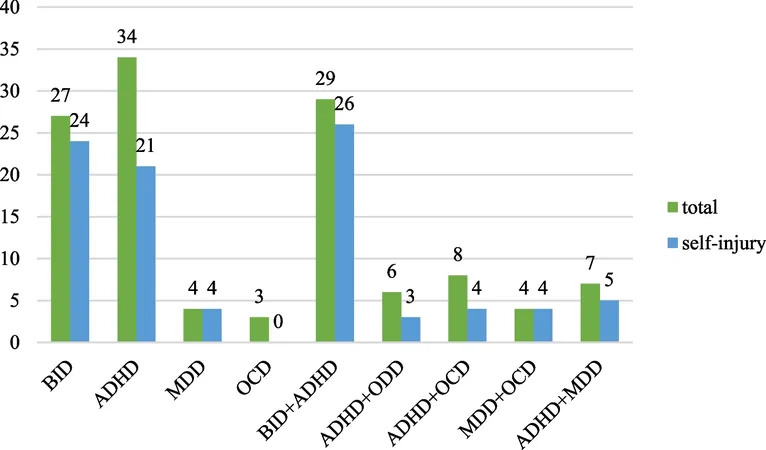
Understanding the Rise of Non-Suicidal Self-Injury Among Adolescents with Mental Health Disorders
2025-01-13
Author: Mei
Introduction
Non-suicidal self-injury (NSSI) is an alarming behavior characterized by direct actions aimed at causing harm, such as cutting or hitting oneself, and indirect methods like substance abuse or engaging in risky behaviors. Such actions, while not necessarily linked to suicidal thoughts, are often viewed through a lens of societal and cultural disapproval.
Prevalence and Demographics
Recent studies have unveiled a troubling rise in NSSI among adolescents and young adults, marking a significant public health concern. A meta-analysis indicates that approximately 17.2% of adolescents have engaged in NSSI at some point, with girls demonstrating a notably higher propensity to self-injure compared to boys—some studies suggest girls are seven times more likely to engage in these behaviors. In Brazil, a staggering 25% prevalence of adolescent self-injury was reported, while Iranian research echoed these findings, revealing that nearly 18% of female students admitted to self-injurious behaviors over the past year.
Importance of Understanding Motivations
Despite this growing trend, understanding the motivations behind NSSI in adolescents, particularly those with existing psychiatric disorders, remains critical for effective prevention and treatment strategies. A significant gap exists in research, particularly concerning adolescents who are actively receiving treatment for mental health issues. These young individuals embody a society's future, underscoring the urgency of addressing their mental and emotional well-being.
Risk of Suicide and Early Identification
Notably, more than 60% of individuals who die by suicide have documented histories of self-injurious behavior. Thus, early identification of NSSI could potentially save lives by facilitating timely intervention. Recognizing the underlying emotions—such as emotional dysregulation or the need for coping mechanisms—of these adolescents could lead to more effective therapeutic methods.
Study on Motivations for NSSI
A descriptive cross-sectional study conducted at the Babol Shahid Yahyanejad Hospital sought to delve into the motivations for NSSI among adolescents aged 12-18 who were undergoing psychiatric treatment. A total of 140 adolescents participated in the study, with a significant portion having histories of self-injury. Written consent was secured from parents or guardians to gather rich and authentic insights through questionnaires.
Findings of the Study
The study revealed groundbreaking findings: 70.7% of the sample had engaged in NSSI, consistent with global trends. Among these adolescents, a majority, 60.7%, were female, indicating a stark gender disparity in self-injury prevalence. Attention-deficit/hyperactivity disorder (ADHD) emerged as the most common psychiatric condition within this demographic, corroborating earlier findings that link ADHD to higher risks of self-injury.
Motivations and Methods of NSSI
Further analysis indicated that emotion regulation was a predominant motivation behind self-injurious behaviors for both boys and girls, aligning with prior studies emphasizing the role of emotional distress. Girls, in particular, exhibited higher overall rates of self-injury; however, certain motivations varied by gender, highlighting a nuanced understanding of why different groups engage in NSSI.
The research also scrutinized various methods of NSSI. Cutting and wounding were the most commonly reported techniques, contrasting perceptions that associate self-injury solely with these acts.
Limitations of the Study
Despite the critical insights garnered, the study is not without limitations, including reliance on self-reported data, which may suffer from biases, and the absence of a control group for robust comparisons.
Recommendations for Future Research
To reinforce mental health support for affected adolescents, future research is recommended to include larger, more diverse populations as well as control groups to comprehensively measure the prevalence of NSSI behaviors. Early diagnosis and intervention for disorders like ADHD and bipolar disorder—common indicators of self-injury risk—are crucial. Cognitive-behavioral therapies and emotion regulation training could pave the way toward healthier coping mechanisms for adolescents, potentially stemming the tide of NSSI behaviors.
Conclusion
Ultimately, understanding the complexities behind NSSI motives is vital for effective treatment strategies and could lead to the development of targeted programs to address this increasingly prevalent issue among youth.


 Brasil (PT)
Brasil (PT)
 Canada (EN)
Canada (EN)
 Chile (ES)
Chile (ES)
 Česko (CS)
Česko (CS)
 대한민국 (KO)
대한민국 (KO)
 España (ES)
España (ES)
 France (FR)
France (FR)
 Hong Kong (EN)
Hong Kong (EN)
 Italia (IT)
Italia (IT)
 日本 (JA)
日本 (JA)
 Magyarország (HU)
Magyarország (HU)
 Norge (NO)
Norge (NO)
 Polska (PL)
Polska (PL)
 Schweiz (DE)
Schweiz (DE)
 Singapore (EN)
Singapore (EN)
 Sverige (SV)
Sverige (SV)
 Suomi (FI)
Suomi (FI)
 Türkiye (TR)
Türkiye (TR)
 الإمارات العربية المتحدة (AR)
الإمارات العربية المتحدة (AR)